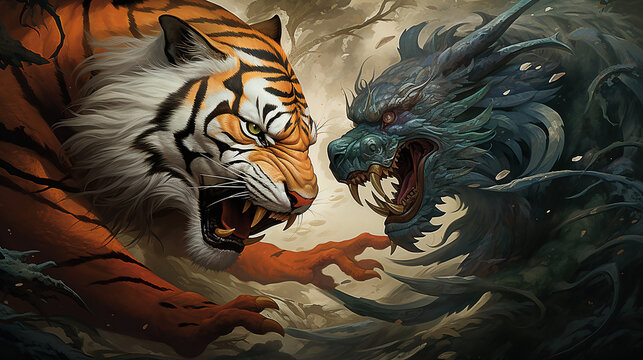
Dragon and Tiger
Art serves as a powerful medium for expressing the essence of the Dragon and Tiger. Through paintings, sculptures, and various art forms, these mythical beings come to life, reflecting the beliefs, values, and emotions of those who create them. This section explores the artistic representations of these legendary creatures.
Traditional Art Forms
In traditional Chinese art, the Dragon and Tiger have been prominent figures in paintings, ceramics, and textiles for centuries.
Dragons are often depicted in flowing, fluid lines, evoking a sense of dynamism and ethereality. Their long, serpentine bodies twist gracefully amidst clouds, symbolizing their connection to the heavens. Artists use vibrant colors and intricate details to convey the dragon’s majesty and power.
Tigers, by contrast, are illustrated with bold strokes and dynamic poses that showcase their strength and ferocity. Artists capture the elegance of the tiger’s movements, illustrating its prowess as a skilled hunter. The contrast between the dragon’s gentle curves and the tiger’s sharp angles creates a visual harmony, echoing their relationship in mythology.
These traditional art forms serve not only as beautiful decorations but also as cultural artifacts that preserve the values and beliefs of past generations. They invite viewers to reflect on the deeper meanings behind these representations, connecting them to the broader cultural landscape.
Contemporary Interpretations
In contemporary art, the Dragon and Tiger continue to inspire artists worldwide, evolving with new techniques and styles.
Modern interpretations often blend traditional motifs with abstract concepts, using mixed media to push boundaries. Some artists reimagine the Dragon and Tiger through street art, murals, and digital platforms, making them accessible to diverse audiences. This evolution fosters a dialogue about tradition and innovation, inviting fresh perspectives on age-old symbols.
Moreover, contemporary art allows for personal expression. Artists may choose to depict the Dragon and Tiger zbet in ways that resonate with their individual experiences, infusing the legend with contemporary issues such as empowerment, identity, and cultural heritage. This creative process inspires viewers to engage with the artwork, prompting reflection on their own lives and communities.
The Influence on Fashion and Design
The allure of the Dragon and Tiger extends beyond traditional art into fashion and design, where their striking imagery captures attention and imagination.
Fashion designers often incorporate these legendary creatures into their collections, creating garments that celebrate their beauty and power. From silk scarves featuring intricate dragon patterns to graphic tees emblazoned with fierce tigers, these symbols evoke a sense of cultural pride and personal empowerment.
Interior designers also utilize the imagery of the Dragon and Tiger to create spaces that reflect balance and harmony. Textiles, wallpapers, and artwork showcasing these creatures can transform environments, fostering a sense of tranquility and vitality. By integrating these symbols into everyday life, people can connect to the rich cultural heritage they represent while enriching their personal spaces.





